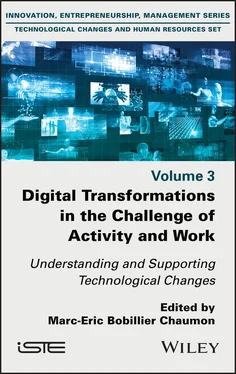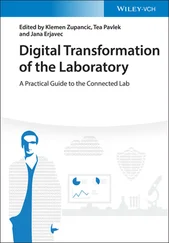Digital Transformations in the Challenge of Activity and Work
Здесь есть возможность читать онлайн «Digital Transformations in the Challenge of Activity and Work» — ознакомительный отрывок электронной книги совершенно бесплатно, а после прочтения отрывка купить полную версию. В некоторых случаях можно слушать аудио, скачать через торрент в формате fb2 и присутствует краткое содержание. Жанр: unrecognised, на английском языке. Описание произведения, (предисловие) а так же отзывы посетителей доступны на портале библиотеки ЛибКат.
- Название:Digital Transformations in the Challenge of Activity and Work
- Автор:
- Жанр:
- Год:неизвестен
- ISBN:нет данных
- Рейтинг книги:4 / 5. Голосов: 1
-
Избранное:Добавить в избранное
- Отзывы:
-
Ваша оценка:
- 80
- 1
- 2
- 3
- 4
- 5
Digital Transformations in the Challenge of Activity and Work: краткое содержание, описание и аннотация
Предлагаем к чтению аннотацию, описание, краткое содержание или предисловие (зависит от того, что написал сам автор книги «Digital Transformations in the Challenge of Activity and Work»). Если вы не нашли необходимую информацию о книге — напишите в комментариях, мы постараемся отыскать её.
Digital Transformations in the Challenge of Activity and Work — читать онлайн ознакомительный отрывок
Ниже представлен текст книги, разбитый по страницам. Система сохранения места последней прочитанной страницы, позволяет с удобством читать онлайн бесплатно книгу «Digital Transformations in the Challenge of Activity and Work», без необходимости каждый раз заново искать на чём Вы остановились. Поставьте закладку, и сможете в любой момент перейти на страницу, на которой закончили чтение.
Интервал:
Закладка:
3.3.4. Sound input and presentation devices
Sound input devices include voice recognition systems. They allow the user to interact with the system through voice commands that are recognized and processed by the computer.
Sound presentation devices include software and hardware interfaces that enable spatialized sound (Tsingos and Warusfel 2006). They allow the simulation of spatial location cues. In other words, the intensity of a sound will depend on the distance between the source of the sound and the user. For example, music emanating from a radio set in a virtual environment will be perceived less and less strongly as the user moves away from it.
3.4. The main areas of application of virtual reality
Virtual reality can find different fields of application; whether in everyday life or at work.
3.4.1. Applications in everyday life
The use of virtual reality for leisure is certainly the most known by the general public. It is used in particular for video games. The arrival of Oculus Rift on the market in 2016, and the falling prices of this type of technology, have made it easier for players to acquire head-mounted displays. They have also prompted video game publishers to offer new products. The games on offer range from free games that come with the head-mounted displays, such as The Lab – which comes with HTC-branded head-mounted displays – to games that are already familiar to gamers on other platforms, such as Fall Out 4.
Virtual reality is also used in the field of art. Some artists paint in virtual reality. Various exhibitions of this type of work have been organized, for example, in the United Kingdom at the Royal Academy in London, or in France as part of the virtual reality exhibition, Laval Virtual. In addition, virtual environments have been developed to introduce the public to artists such as Rembrandt ( Meeting Rembrandt: Master of Reality ) or Van Gogh ( The Night Cafe: A VR Tribute to Vincent Van Gogh ).
Tourism offers users the opportunity to visit destinations in immersive virtual environments. For example, they can visit the Lake District National Park in the United Kingdom (tom Dieck et al . 2018) or the Fontanelle Cemetery in Naples (Marasco et al . 2018) in this way.
3.4.2. Applications in various professional contexts
Virtual reality is also used in professional contexts. In education, it is frequently used as a pedagogical tool, particularly for learning science. For example, it can illustrate the expression of proteins in mammals (Makransky et al. 2019) or the composition of molecules (Merchant et al . 2012).
Virtual reality is more widely used in vocational training contexts. There are a multitude of examples in this field. Surgery training is common (Fang et al . 2014; Khan et al . 2014), as is maintenance training (Gomes De Sá and Zachmann 1999; Ganier et al. 2013; Gavish et al . 2013). Applications have also been developed for assembly training, for example, for truck chassis (Ordaz et al . 2015) or car doors (Langley et al . 2016). There are also applications designed for risk prevention training, for example, in the construction sector (Sacks et al. 2013) or for home helpers (Polivka et al . 2019).
Virtual reality is also found in the field of design. In this context, it is used to replace or complement a physical prototype of a future product. Designers use virtual reality to inspect the product, to manipulate it, to evaluate it and to make design decisions. This applies to both vehicle design (see, for example, Berg and Vance 2017) and microwave oven fronts (Bruno and Muzzupappa 2010). It is also used in architecture (Paes et al. 2017), urban planning (Maffei et al . 2015) and landscaping (Guo and Yang 2013). The use of virtual reality to design manufacturing stations is common (Aromaa and Väänänen 2016; Bernard et al . 2019; Sagnier 2019).
Virtual reality is also becoming an increasingly therapeutic environment. It allows professionals to expose their patients to certain situations in a controlled and risk-free environment. In this context, it is integrated into the treatment of post-traumatic stress (Moraes et al. 2016) or delusions of persecution (Freeman et al . 2016). In addition, it can be used as a rehabilitation tool, for example, to treat balance disorders caused by certain pathologies (Hsu et al . 2017), or to offer upper limb rehabilitation after a cardiovascular accident (Shin et al. 2014).
Finally, virtual reality is proving to be a research tool. It enables the visualization and manipulation of different types of data, for example microscopic data (Theart et al. 2017) or atmospheric data (Helbig et al . 2014). It also allows psychological researchers to study user behavior. To illustrate this use of virtual reality, we can cite a study by Coeugnet et al . (2018) on the use of vibrotactile watches as a means of navigating a city, or a study by Morrongiello et al . (2019) on the behavior of children when crossing the road.
3.5. Applications of virtual reality in industry
In industry, virtual reality can be applied in two ways: at the design and training levels (see Moreau et al. 2004; Mujber et al. 2004; Hamid et al. 2014).
For design in industry, virtual reality is mainly used for virtual prototyping, project reviews and ergonomic studies of workstations. Virtual prototyping consists of replacing or supplementing physical prototypes of products or workstations with virtual modeling (Mujber et al. 2004). It is then possible for designers to conduct simulations, evaluate the product and make modifications at a lower cost. For example, Bordegoni and Ferrise (2013) illustrate how a virtual prototype can be used in product evaluation. The system they use is multi-sensory. It includes a haptic arm, a projection screen with stereoscopic vision and speakers. The authors present the use of this system to represent a washing machine. Participants in the study had to follow a scenario to interact with the virtual prototype and the physical prototype of the product.
Virtual prototypes can also be used for project reviews. In this context, different professions meet around a virtual environment and make design decisions on the designed product. For example, in the aeronautics industry, project reviews bring together project managers and the future fitters who will assemble the aerostructure, around virtual prototypes of manufacturing workstations (Sagnier et al. 2019). Finally, it is also possible to use the virtual prototype to carry out ergonomic studies of the workstations. For example, Bernard et al . (2019) simulated helicopter maintenance operations, in order to collect data on the operators’ postures, the biomechanical constraints to which they were subjected, or their mental load.
Virtual reality also allows for virtual assemblies, that is, simulating the assembly of parts of an object (Seth et al. 2011). In this way, we can decide on the assembly sequence of the different parts, determine the physical and mechanical characteristics of the parts, choose the tools to be used and identify factors that may affect the quality of the assembly (Mujber et al. 2004). For example, Jayraman et al. (1997) developed VADE (Virtual Assembly Design Environment), an immersive virtual environment for virtual assembly. The virtual reality system used consists of a head-mounted display and a data glove to detect the user’s hand movements. The system integrates data from CAD (Computer Aided Design) software on tolerances, part location, part orientation, etc. In the virtual environment, the user assembles or disassembles the different parts of an object, perceives the collisions of the parts and can record a trajectory, or reject it.
Читать дальшеИнтервал:
Закладка:
Похожие книги на «Digital Transformations in the Challenge of Activity and Work»
Представляем Вашему вниманию похожие книги на «Digital Transformations in the Challenge of Activity and Work» списком для выбора. Мы отобрали схожую по названию и смыслу литературу в надежде предоставить читателям больше вариантов отыскать новые, интересные, ещё непрочитанные произведения.
Обсуждение, отзывы о книге «Digital Transformations in the Challenge of Activity and Work» и просто собственные мнения читателей. Оставьте ваши комментарии, напишите, что Вы думаете о произведении, его смысле или главных героях. Укажите что конкретно понравилось, а что нет, и почему Вы так считаете.












